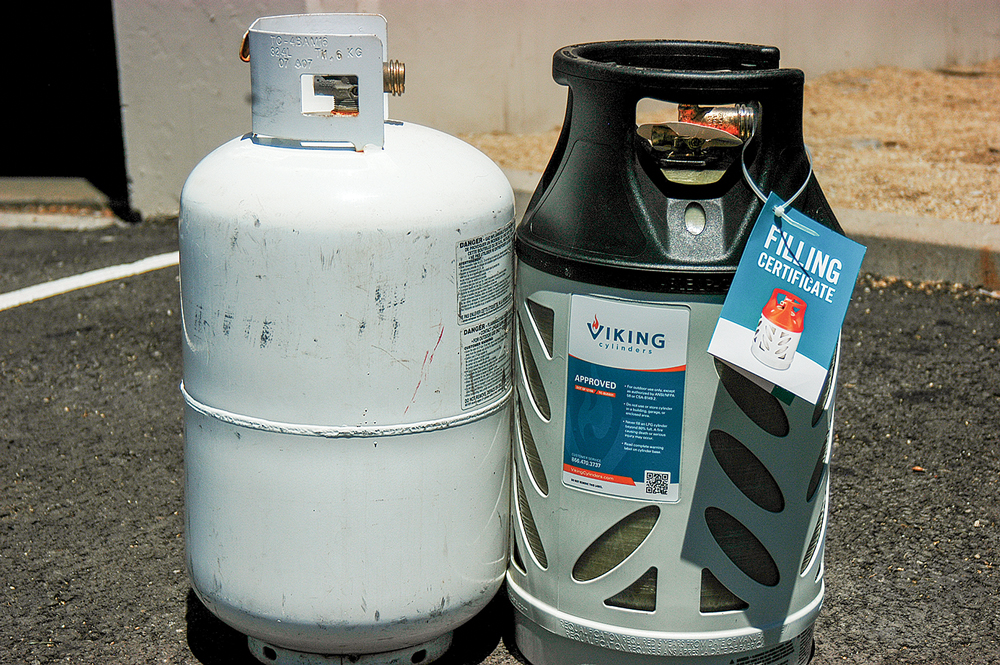Viking Cylinders add a touch of class aesthetically, while reducing weight and providing users with a clear view of the LP-gas level
Carrying LP-gas on a trailer is essential for self-containment. Propane, as it’s usually referred to, provides the energy to fire up the furnace, operate the stove/range, heat the water and operate the refrigerator when 120-volt AC power is not available or when we’re on the road. It just plain works, and perhaps that’s why nothing has changed in RV LP-gas systems for as long as anyone can remember. But a company out of Norway, Viking Cylinders (Hexagon Ragasco), has changed that with effective, attractive solutions for the three most common concerns of using steel LP-gas cylinders: weight, level visibility and rusting.

When comparing the typical steel LP-gas cylinder on the left with the Viking, there’s a striking difference in appearance, although the physical size is similar.
Viking tackled the weight issue by constructing its cylinders using a special mix of fiberglass and plastic resins, covered in a durable plastic outer case. Cylinder sizes are somewhat different than what trailer owners are familiar with, and the most common size the company is marketing is 5.2 gallons — slightly larger than the standard steel 5-gallon model and smaller than the 7-gallon cylinders found on most moderate and large travel trailers and fifth-wheels.
Beyond the fact that these cylinders are about 50 percent lighter than their steel counterparts, they are also translucent, which solves the issue of accurately monitoring the propane level. All one has to do is look on the side of the cylinder to see the level in its liquid state. The materials are also noncorrosive, so the Viking cylinders will never rust or degrade, according to the company. In the event of a fire, the resin will burn off and the plastic liner and casing will melt, preventing an explosion, according to the company, although the escaping propane will still burn.
Viking cylinders have a decorative design on the outside that is aesthetically pleasing. There are color options for the smaller cylinders, but the model we installed only comes in black. Ergonomic grips make it easy to handle when it comes to moving off the A-frame for filling; a wide base provides additional stability when transporting. Size designations are in pounds; the one we tested is a 22-pound vapor model. A 31-pound vapor (7.3-gallon) cylinder is also offered but was out of stock as of this writing. The company will expand U.S. distribution of the larger cylinder as demand increases, something that is bound to happen, since most RVers prefer having more capacity.
For those who want to fuel barbecues and outside lights, the 11-pound (2.6-gallon) and 17-pound (4-gallon) vapor cylinders fit the bill nicely. These cylinders are not cheap, but the $160, $150, $140 and $115 prices for the respective sizes takes into account the extended longevity and natural resistance to the elements.
To mount these cylinders on the A-frame, Viking offers a tray and mounting kit ($25) that must be used. That’s because the cylinder bottom dimensions and top handle/rail are different from the standard steel cylinders. The remainder of the kit comes with a new steel cylinder tray and matching hold-down with hardware.
Only a couple of steps are necessary to make the swap. Remove the original tray from the trailer’s A-frame by either unbolting or using a cut-off wheel and grinder, if welded on. With all the old parts out of the way, the new tray can be located in the same vicinity, making sure there’s clearance for spring-bar brackets and the A-frame jack. We opted to upgrade from the included small self-tappers to ¼-inch-20 bolts with lock washers and nuts for added strength. From there, it’s just a matter of reusing the all-thread for the hold down, resecuring everything as it was before and leak checking if you disconnected any propane fittings (to accommodate longer hoses, if necessary), other than the Type 1 connectors.
Is it really worth the effort and cost? Definitely! Not only will you remove several pounds of hitch weight, and increase durability and safety, but the refilling process will be easier. Can you really see the liquid level? Yes, although it takes a couple of minutes and maybe the right light to find it.
Viking Cylinders
www.vikingcylinders.com









